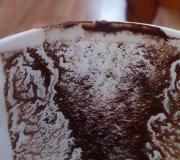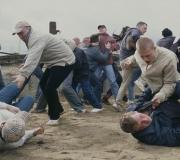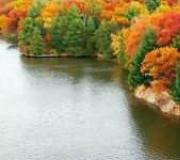Vorobyov Maxim Nikiforovich – gallery of works (87 images). The Vorobyovy family business is ruining the Moscow region
M.N. Vorobyov was the son of a non-commissioned officer, who, after retirement, was hired as a caretaker at the Academy of Arts. Here I received my education future artist: in 1798. He was enrolled in the architectural class, headed by J.B. Thomas de Thomon, and graduated from the Academy of Arts in 1809 in the class of landscape painting.
Vorobyov’s life turned out well: in 1814 he became an academician, in next year began teaching, in 1823 he received the title of professor, and in 1843 - emeritus professor.
Wide educated person, subtle connoisseur art, an outstanding violinist, Vorobiev early felt the need to abandon outdated forms and rules. The first works in which Vorobyov’s originality was manifested were drawings and watercolors made at the Nikolskoye-Tverskoye estate of L. N. Lvov. In May 1812, on his way to Moscow, the young artist stopped at Lvov. Here Vorobyov created many drawings, testifying not only to his remarkable talent, but also to his new attitude to the landscape genre.
He trained several dozen students, among whom there were many excellent landscape painters (I.K. Aivazovsky, A.P. Bogolyubov, L.F. Lagorio, G.G. and N.G. Chernetsov, etc.); At the same time, he himself never gave up his brush all his life. Vorobyov wrote urban and seascapes, architectural monuments and views of nature, and sometimes episodes of war.
Vorobyov traveled a lot around Russia, visited abroad several times and created new works based on his impressions from his trips. In 1813-14 the artist visited with Russian troops in Western Europe; the result of the trip was his canvas depicting a solemn prayer service performed by the Russian clergy in Paris on the occasion of the victory. A little later he performed a series of excellent views of Moscow, mainly painting the Kremlin.
Among famous paintings: “Entrance to the Church of the Resurrection of Christ in Jerusalem” (1822), “Interior view of the Church of Calvary in Jerusalem” (1824), “Interior view Armenian Church in Jerusalem" (1820s), etc. At the end of the 1820s. the artist also visited the theater of military operations on the Danube. Based on the sketches and sketches made during the trip, landscapes of magnificent color were painted: “Bosphorus”, “Seashore near Varna” (both 1829). Vorobyov's paintings were invariably successful with the public and critics, and he had to repeat many of them for customers.
Still, the most valuable part of the artist’s heritage is the St. Petersburg landscapes, created mainly during his time creative flourishing, in the 1820-30s. Romantic image St. Petersburg with its cool beauty appears in the landscapes “Sunset in the vicinity of St. Petersburg” (1832), “Neva embankment near the Academy of Arts” (1835), “ Moonlight night in St. Petersburg" (1839), "Construction of St. Isaac's Cathedral", " Peter-Pavel's Fortress"(both 1830s), etc.
Sunrise over the Neva View of Jerusalem An oak tree crushed by lightning
Saint Isaac's Cathedral and the monument to Peter I Alley in Albano View of the military telegraph near Varna
View of the city of Grodno View Palace Embankment in St. Petersburg View of Jerusalem
View from the window View of the Moscow Kremlin (from the side of the Kamenny Bridge) View of the Moscow Kremlin from the side of the Ustinsky Bridge
View of Constantinople View of Rome View from the Elagin Terrace
View of the Gruzino estate from the Volkhov side Sunrise over the Neva Elagin Island at night
Sunset in Rome Sunset in the vicinity of St. Petersburg Italian landscape
Moonlight night in St. Petersburg Neva embankment near the Academy of Arts Odessa
Autumn night in St. Petersburg. Marina with Egyptian sphinxes on the Neva at night Peter and Paul Fortress Visit to two Arab sheikhs
Seaside view in Italy Smyrna
Vorobyov Maxim Nikiforovich (1787-1855)
M.N. Vorobyov was the son of a soldier who rose to the rank of non-commissioned officer, and after retirement, he was hired as a caretaker at the Academy of Arts. Here the future artist was educated: in 1798 he was enrolled in the architectural class led by J.B. Thomas de Thomon, and graduated from the Academy of Arts in 1809 in the class of landscape painting.
Vorobyov's life turned out well: in 1814 he became an academician, the next year he began teaching, in 1823 he received the title of professor, and in 1843 - emeritus professor.
He trained several dozen students, among whom there were many excellent landscape painters (I.K. Aivazovsky, A.P. Bogolyubov, L.F. Lagorio, G.G. and N.G. Chernetsov, etc.); At the same time, he himself never gave up his brush all his life. Vorobyov painted city and seascapes, architectural monuments and views of nature, and sometimes even episodes of war.
He traveled a lot around Russia, visited abroad several times and created new works based on his impressions from his trips. In 1813-14 the artist visited Russian troops in Western Europe; the result of the trip was his canvas depicting a solemn prayer service performed by the Russian clergy in Paris on the occasion of the victory. A little later he performed a series of excellent views of Moscow, mainly painting the Kremlin.
Vorobyov became widely famous for his paintings created after a trip to the Middle East (1820-21): “Entrance to the Church of the Resurrection of Christ in Jerusalem” (1822), “Interior view of the Church of Calvary in Jerusalem” (1824), “Interior view of the Armenian Church in Jerusalem" (1820s), etc. At the end of the 1820s. the artist also visited the theater of military operations on the Danube. Based on the sketches and sketches made during the trip, landscapes of magnificent color were painted: “Bosphorus”, “Seashore near Varna” (both 1829). Vorobyov's paintings were invariably successful with the public and critics, and he had to repeat many of them for customers.
Still, the most valuable part of the artist’s heritage is the St. Petersburg landscapes, created mainly during his creative heyday, in the 1820-30s. The romantic image of St. Petersburg with its cool beauty appears in the landscapes “Sunset in the vicinity of St. Petersburg” (1832), “Neva embankment near the Academy of Arts” (1835), “Moonlit night in St. Petersburg” (1839), “Construction of St. Isaac’s Cathedral”, “Peter and Paul fortress" (both 1830s), etc.
A widely educated man, a keen connoisseur of art, an outstanding violinist, Vorobyov early felt the need to abandon outdated forms and rules. He realized that it was time to turn directly to the study of nature. The first works in which Vorobyov’s originality was manifested were drawings and watercolors made at the Nikolskoye-Tverskoye estate of L. N. Lvov. In May 1812, on his way to Moscow, the young artist stopped at Lvov. Here Vorobyov created many drawings, testifying not only to his remarkable talent, but also to his new attitude to the landscape genre.
Vorobiev Maxim Nikiforovich is a Russian painter, a magnificent master of landscape, and a representative of romanticism. Vorobiev occupies a significant place in the history of Russian painting, both as an artist and as a mentor to a whole generation of Russian landscape painters. Born in 1787 in the family of a janitor at the Academy of Arts. Vorobiev entered the academy as a student at the age of ten, and showed great success in drawing, perspective, architecture and landscape painting.
Sunrise over the Neva, 1830, Kirov Art Museum

View of Jerusalem, 1821, Omsk Art Museum

View of the Moscow Kremlin from the Ustinsky Bridge, 1818, Tretyakov Gallery

Seaside view in Italy, 1840s, Russian Museum
The first teacher was Professor Thomas de Thomon; the artist's subsequent mentors were Fyodor Yakovlevich Alekseev and, probably, the landscape painter Mikhail Matveevich Ivanov. The type of painting chosen by the young artist, or rather, assigned to him by his academic superiors, was architectural and landscape painting.
In 1809, Fyodor Yakovlevich Alekseev, a landscape painter of a decorative direction, a member of an expedition to study the historical areas of Central Russia, received young Vorobyov as an assistant to paint views of cities. To revive these species human figures Alekseev decided to depict episodes of visits to cities by the sovereign. This official task was completed by the artist Alekseev and the young Vorobyov with success. In 1813–1814, Vorobiev was present at the main apartment of Emperor Alexander I in Germany and France.
In 1820, Vorobiev made, on behalf of the government, a trip to Palestine, where he drew, measured and sketched everything the most important places revered by Christians. The difficulty of this enterprise was that all measurements and drawings had to be done secretly from the supervision of local Muslim authorities.
In addition to temples, Vorobyov painted several landscape views of Jerusalem and Dead Sea, and on the way to Palestine - views of Constantinople, the island of Rhodes, Smyrna, Jaffa and other cities. All these materials for future paintings were contained in 90 sheets watercolor drawings some sketchy, some very finished. Vorobyov's journey to the Holy Places was arranged by Nikolai Pavlovich, then still the Grand Duke, who wanted to restore the Church of the Resurrection of Christ in New Jerusalem, in the vicinity of Moscow, to its proper form.

Oak crushed by lightning, 1842, Tretyakov Gallery

St. Isaac's Cathedral and monument to Peter I, 1844, Russian Museum

Italian landscape, 1847, Historical and Architectural Museum, Istra

Sunset in Rome, 1851, Tver Art Gallery

Alley in Albano, 1820s, National Museum The Republic of Belarus

Evening with the Arab Sheikh Abu Ghosh, private meeting
Upon returning to St. Petersburg, Vorobyov painted the painting “The Entrance of the Church of the Resurrection in Jerusalem” in 1823 and the same year - the painting “Neva from the Trinity Bridge by Moonlight.” Later - “The interior of the chapel of Golgotha in the Church of the Resurrection.” In 1827, Vorobiev wrote: “Sunrise over the Neva”, “Dead Sea”, genre painting"Evening with the Arab Sheikh Abu Ghosh", "View of Smyrna". During Turkish war in 1828, Vorobiev was part of the sovereign's retinue to draw and write sketches according to the instructions of his majesty. The fruit of this time were, among other things: “View of the siege of Varna”, “Explosion of Varna”, “View of Odessa”, “The ship during a storm on which the sovereign was”.
Deeply held memories of Jerusalem were brought back to life 16 years after the Palestinian journey (" General form Jerusalem", as well as "View of Constantinople from the Asian shore"). In 1840, the sad period of the artist’s life began; having lost his dearly beloved wife that year, Vorobiev began to degenerate morally for the worse, fell into excesses, which developed in him a disease from which he died in 1855. The last years of his life he studied mainly Italian views, based on sketches he made in the vicinity of Rome and Palermo during his travels of 1844–1846.
(1787 – 1855)
One of the leading Russian landscape painters of the first half of the 19th century, the author of highly successful urban and sea views in the style of soft romanticism. During his lifetime he was called “the most famous of Russian painters” and considered “the father of Russian landscape painting.”
A student of Fyodor Alekseev, Mikhail Vorobyov was a master of urban landscapes. In his best canvases he reached great emotional heights, this especially applies to his views of St. Petersburg at night. And his eastern series of 1820-1821 was discovered in Russian art the theme of orientalism.
No less important for Russian painting is the importance of Mikhail Vorobyov as a teacher. At the Academy of Arts he led the “class of landscape and perspective painting.” He trained dozens of students, including many famous artists- brothers Chernetsov, Lebedev, Aivazovsky, Bogolyubov, Lagorio and others.
Mikhail Nikiforovich Vorobyov was born on August 6 (17), 1787 in the city of Pskov in the family of a soldier, who in 1796 entered the service at the Academy of Arts “to teach music to students.” He studied at the Academy from 1798 to 1809 in the class of perspective painting with J. Thomas de Thomon and F. Ya. Alekseev.
In 1809 he was awarded a large gold medal, received a 10th degree certificate for the title of class artist and, in view Napoleonic Wars, left at the Academy as a pensioner. In 1814 he received the title of academician and from 1815 he began teaching architecture and perspective in a painting class, as an assistant to Fyodor Alekseev.
In 1820 - 1821, as part of the diplomatic mission of D.V. Dashkova, he went on a trip to the Middle East, visiting Constantinople, Smyrna, Jerusalem, Bethlehem and other cities of Palestine. The result of the trip was a unique series of sketches and studies, which introduced an “oriental” flavor into Russian art.
In 1823 he received the title of professor of perspective, from 1824, after the death of F. Alekseev, he headed the perspective class, and from 1826 - the class of landscape painting and perspective.
In 1828 during Russian-Turkish War was assigned to the Headquarters of the 2nd Army on the Danube. Having spent the summer and autumn near Shumla, Varna and other locations of Russian troops, he completed numerous drawings and watercolors, which later served as material for paintings.
IN last years During his life he worked mainly on Italian views based on sketches made during his travels in 1845-1846 in Italy, Switzerland and Germany.
5. Vorobyov Maxim “Parade on Palace Square in St. Petersburg" 1817 Oil on canvas 47.5x64.5 State Russian Museum 6. Vorobyov Maxim "View of the Moscow Kremlin (from the side of the Ustinsky Bridge)" 1818 Oil on canvas 42.5x67.7 State Tretyakov Gallery
7. Maxim Vorobyov “View of the Moscow Kremlin (from the Kamenny Bridge)” 1818 Oil on canvas 42.6x65.5 State Tretyakov Gallery 8. Maxim Vorobyov “View of the Moscow Kremlin (from the Kamenny Bridge)” 1818 Oil on canvas 63.5x100 State Russian Museum
Chairman of the Board of Directors of PJSC Russian Aquaculture
In 1998 he graduated from the Faculty of International Economic Relations of MGIMO.
He holds an MBA from the Spanish Business School IESE in International Economics.
Since 1997 he has been working at JSC Russian Sea. He started working in the company as a sales manager, then moved to the position of plant manager.
2006-2007 - General Director of LLC Management Company Russian Sea.
Since November 2007 – Chairman of the Board of Directors of the Russian Sea Group of Companies
Since 2007 - Chairman of the Board of Directors of the Glavstroy-SPb company.
Since April 2009, he has held the position of member of the supervisory board of Bank St. Petersburg.
In 2009, he was also the General Director of the Russian Sea company and the Russian Sea group of companies.
Maxim Vorobiev in the news
Control over RRPK will pass to Gleb Frank
One of its co-founders, Gleb Frank, will become the controlling shareholder of the Russian Fishery Company. He acquires the share of his partner Maxim Vorobyov.
Russian Aquaculture has lost shareholders
The son-in-law of billionaire Gennady Timchenko, Gleb Frank, left the shareholders of the Russian Aquaculture company. For 37.1% of the shares, he could gain 1 billion rubles, Vedomosti reports.
"Murmansk salmon" will conquer Siberia
On May 21, the Russian Sea - Aquaculture company opened a new fish processing plant in the Murmansk village of Ura-Guba. Chilled products are designed to compete with Norwegian salmon, primarily by reducing delivery times to the consumer.
“Russian Sea – Production” will cease to be “Russian”
LLC "Russian Sea - Extraction", which this year became the owner of large fishing assets in Far East, ordered a marketing study, based on the results of which a decision will be made to change the company’s name.
The new CEO of Russian Sea will focus on business growth
For the position general director Dmitry Dangauer has returned to the Russian Sea group of companies. The board of directors believes that his candidacy is optimal for solving the problems of developing distribution and aquaculture.
"Russian Sea" has lost interest in processing
Russian Sea Group of Companies is selling its fish and seafood processing division. The group will focus on the development of fisheries production, distribution and aquaculture.
Pacific Andes asked from the Russian fishing industry
The head of the FAS, Igor Artemyev, said that a number of Russian companies are already negotiating to acquire assets from the Chinese holding Pacific Andes. However, the largest market players have not yet confirmed this information.




